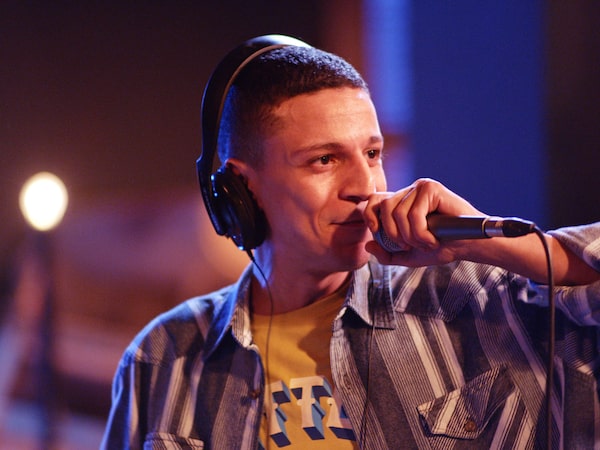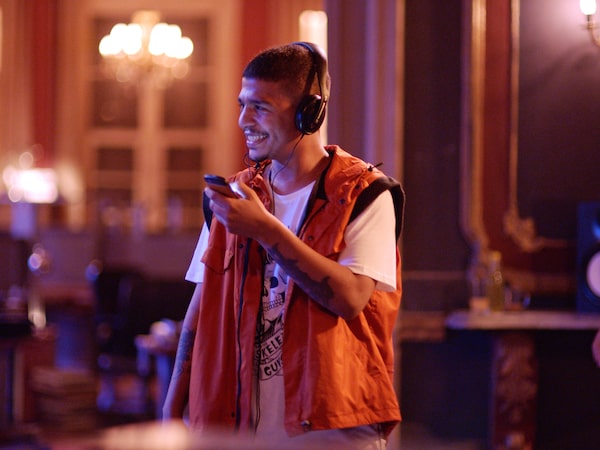
Rapper Joker performs a verbal two-step around the politics of his complaints, trade lyrics with Raptor (not seen) while in Cairo.Courtesy the artist, Victoria Miro, London and Venice, and David Zwirner, New York, London, Paris and Hong Kong.
Raise your hand if you remember what happened in 1848. And don’t all jump up at once.
Vancouver artist Stan Douglas titled his Venice Biennale show 2011 ≠ 1848, laying a history lesson on top of work about 21st-century politics. As Douglas examines protest as performance with a video of cross-cultural rappers and staged photos of street riots that took place in 2011, you’ll recall that we are all still very angry about the state of the world right now. Whatever happened back in 1848, what we need to know is whether current anger will actually lead to future change.
2011 ≠ 1848 will be showing in Venice until the end of November but now Canadians will also get a chance to see what is representing this country at the so-called Olympics of visual art without having to travel to Europe. A second edition of its two-channel video installation and four large-scale photographs is starting a national tour at the Polygon Gallery in Vancouver. This is an important move for the National Gallery of Canada, which organizes the Biennale contribution, and is now touring Douglas’s show to Vancouver, Saskatoon and Ottawa.
Of course, this is only possible because Douglas works in photo and video. Several of his predecessors at the Canada Pavilion in Venice’s Giardini have done one-off site-specific installations that can’t easily be toured. So, there’s an opportunity now in Vancouver – to be followed by Saskatoon and Ottawa in 2023 – to see what all the fuss is about. After all, the international press considers 2011 ≠ 1848 a Venice must-see.
There, the videos are off-site, in a 16th-century salt warehouse, but Polygon director Reid Shier, who curated the Biennale show himself, has brought the two bodies of work together under one roof at his home venue. Now it begins – cheerfully, infectiously – with the videos of the rappers.
Douglas’s conceit is that it’s 2011 and two pairs of rappers, one British from the grime scene, the other practitioners of Egypt’s mahraganat, are communicating via phone lines in a kind of cross-cultural call and response. (They are all real musicians who auditioned for these roles but they were actually filmed at separate times.) The piece is titled ISDN (for integrated services digital network) and only geeks are going to get the reference to the dated digital telephone technology that is supposedly permitting the exchange, but everyone can grasp the joyous form of rebellion that confirms popular music as a crucial creative outlet for social protest.
In London, TrueMendous and Lady Sanity spit out a litany of witty retorts to racism and sexism. Meanwhile, in Cairo, Joker and Raptor speak more elliptically and poignantly of competitions with each other and their personal struggles. Their Arabic lyrics are subtitled in English so you can often follow them more easily than the women’s thick British accents. If youth feels their lives are crap, maybe someone in authority is to blame, but the young Egyptians perform a verbal two-step around the politics of their complaints. Their hesitancy is a response to an actual fear of censorship in Egypt today, in 2022.
Douglas, himself a tech geek, has programmed his video edits and music tracks on random repeats. In theory, it would take two weeks to see and hear every combination of image and music; in practice you can grasp most of the lyrics in a 20-minute sitting, book-ended with drone shots of Cairo at dusk and London by night. Still, every time you try to leave the room, something new seems to be starting as the videos present an experience of a musical force continually renewing itself. All this energy has to be a good thing.
Douglas’s photographs, in the next room at the Polygon but the main event at the Canada Pavilion in Venice, are darker in theme and more ambiguous. Using a technique he developed in a history series he created for New York’s Penn Station, Douglas has restaged four protests that took place in 2011. He poses costumed actors and then drops these tableaux into aerial shots of the actual places. (God bless drone photography, although the inspiration for this project was actually a shot of London’s Mare Street taken from a helicopter. It’s included as a coda to the Polygon show.)

Raptor speaks poignantly about his personal struggles while an audience watches in Cairo.Courtesy the artist, Victoria Miro, London and Venice, and David Zwirner, New York, London, Paris and Hong Kong.
In the streets of Tunis, on Jan. 23, 2011, small groups begin to gather in the dusk. The feel is almost romantic. Will history be made on this Arab night? In London’s Pembury housing estate in August after a police shooting, the groups of youths are also small, but the atmosphere is grimmer and tenser. On the Brooklyn Bridge in October, the police are kettling members of the Occupy Wall Street movement and one person is being hauled away by police. Meanwhile in Vancouver, during the Stanley Cup riot of June, 2011, fans cheer as a car burns.
The artist’s point about 1848 is that the European revolutions of that year, although rapidly suppressed, did eventually lead to political change. So if we take that ≠ sign at face value, 2011 apparently produced nothing: The Arab Spring fizzled disappointingly and the disparities of wealth targeted by the Occupy protests grow wider by the day.
You can mull over the current drift of politics but, before you do, appreciate the visual aspects of these photographs. If you look at the figures on Brooklyn Bridge in particular, you can see they are dropped onto the background and didn’t actually inhabit this space. Similarly, the grimacing Stanley Cup fans in their face paint and coloured jerseys are clearly posing while that burning car was safely torched somewhere else. The artifice is all intentional.
Douglas often compares his work to traditional history painting and admires the art of Pieter Bruegel, known for the way he combined multiple moments in one grand scene. Here the artist is restaging recent history, freezing the chaotic atmosphere of a protest where afterward no one can quite remember what happened just before the batons fell or the bullets flew. By stilling the stuff of TV footage, he elevates it, and so we are forced to slow our pace and consider what we see. We probably wish the Arab Spring had succeeded, but how much do we sympathize with the Stanley Cup rioters, some of whom seemed determined to do violence even before it became clear the Vancouver Canucks would lose the game. In Washington, was Jan. 6, 2021, just another manifestation of that same discontent?
Traditional history painting, from the death of Wolfe to the victories of Napoleon, is propaganda. Douglas’s work has an ambivalence that is wholly contemporary. It’s far easier to spend time toe-tapping to an electronic beat and nodding along with his mouthy rappers, but the photos ask hard questions about where protest might go next.
2011 ≠ 1848 continues at the Polygon Gallery in North Vancouver to Nov. 6. It will show at Remai Modern in Saskatoon from January to April, 2023 and at the National Gallery in Ottawa in fall, 2023.
 Kate Taylor
Kate Taylor